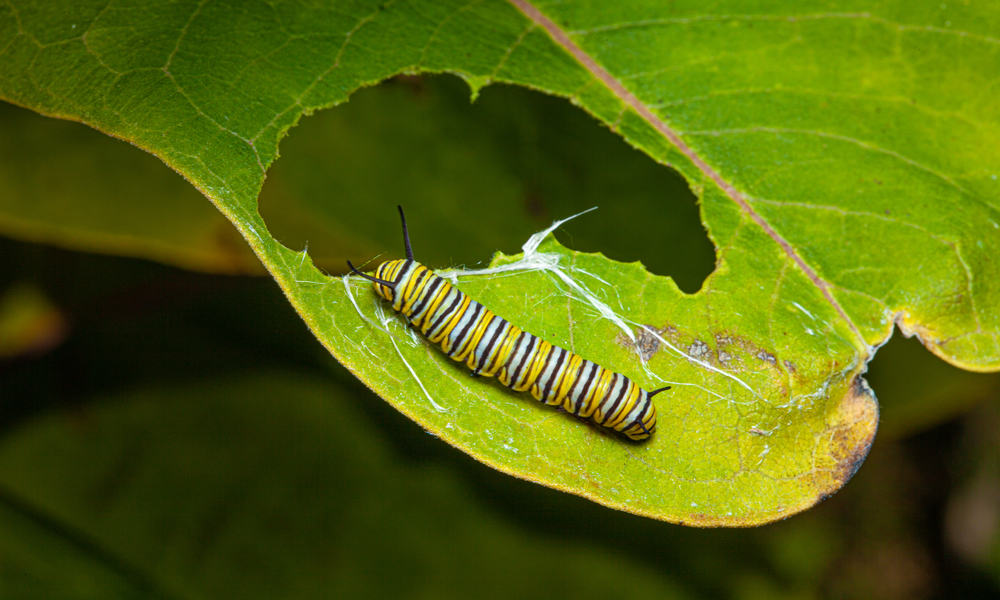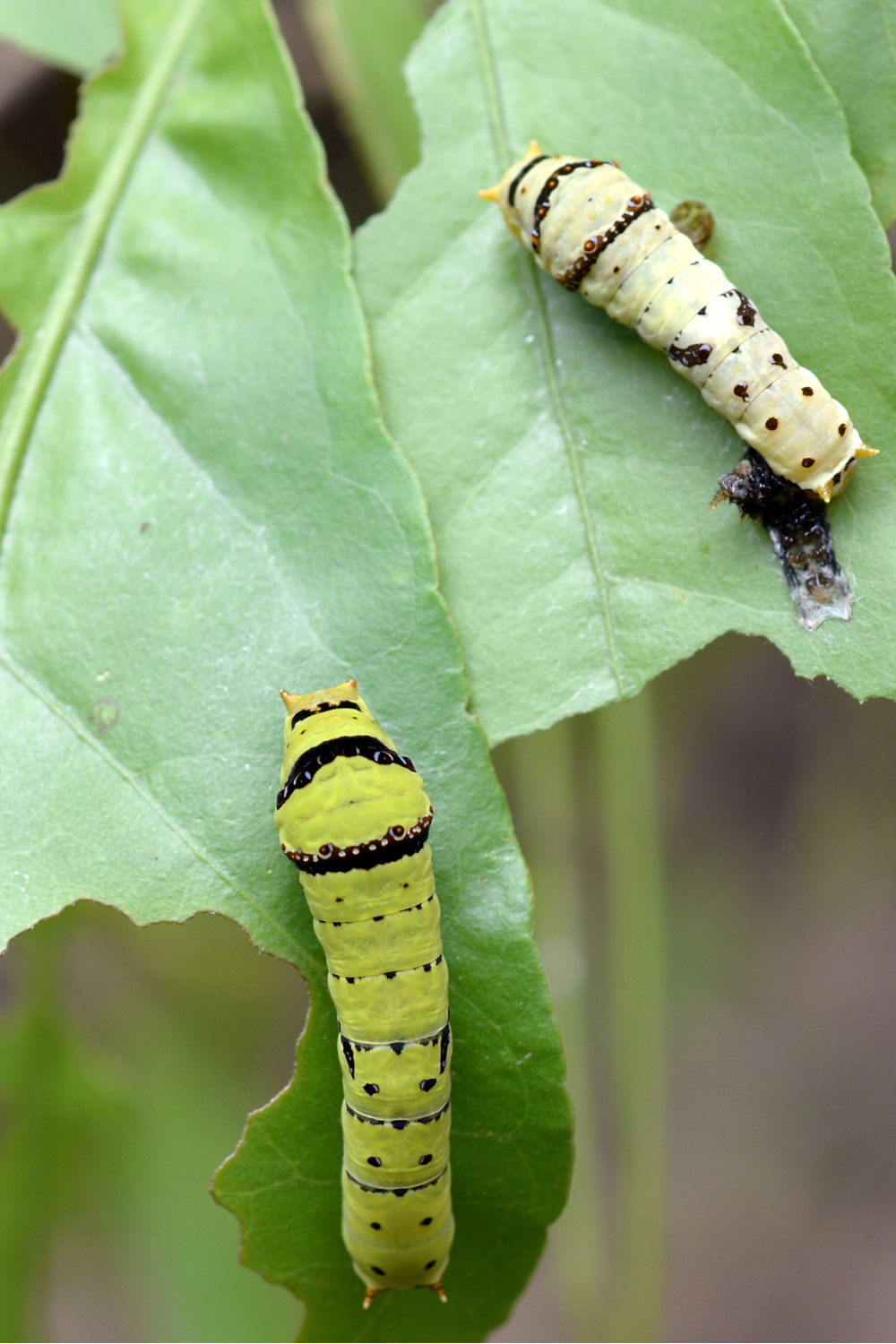Caterpillars are a common sight in summer, and you will surely see them while crawling over the plant’s leaves in search of food. These insects are herbivores or omnivores, and they can be picky in plant choice. If you are a lucky one and have your own garden, you need to know what do caterpillars eat to protect your plants on time.
What Do Caterpillars Like to Eat
Caterpillars hatch from moths’ eggs and butterflies laid on the host plant’s leaves. Butterflies and moths carefully choose plants for laying eggs, and typically, each caterpillar species has its favorite host plant.
The caterpillars have strong jaws and begin to eat the host plant leaves immediately after their birth. They are unbelievably voracious during the first two weeks of life but focus only on necessary feeding after that to accelerate their growth.
Interestingly, the caterpillars will refuse to eat leaves and die when find themselves on plants that don’t suit their type. You can recognize:
- Universal caterpillar feeders that can eat any plant
- Specific caterpillar feeders that only consume particular plants
Caterpillars never drink water but only eat more leaves when they are thirsty. Keep in mind that captive-bred caterpillars have a partially different diet than caterpillars in the wild. They will enjoy nibbling:
Nettle
Nettle is a yummy and one of the favorite plants for caterpillars. Therefore, some insects preferably pick it out as the host plant to lay eggs on its leaves whenever possible, including:
- Peacocks
- Red admirals
- Notches
- Small tortoiseshell butterflies
Moss and lichens
You can find lichens on old walls, tree trunks, and decaying plant waste. Offer them to young moth caterpillars, including:
- Scarce footman
- Rosy
- Muslin
- Dingy
- Buff
Bark and twigs
Caterpillars often make holes in the tree bark and feed on the tree’s inner bark. On average, they can live there for almost two years before harming a tree.
Wild grass
Caterpillars like Meadow Brown, Gatekeeper, and Skipper are species that feed primarily on wild grass. You can make it easier to nourish these caterpillars by not mowing your garden regularly.
Oak leaves
These leaves are among the best foods for caterpillars. Providing that the caterpillars don’t want to eat anything you give them, offer them oak leaves.
Flowers
Some caterpillar species enjoy the dandelion, clover, cuckoo, and the bird’s foot trefoil flowers.
Alder Buckthorn
Brimstone butterfly caterpillars preferably eat the Alder Buckthorn tree leaves.
Honeycombs
Some types of caterpillars feed on honeycombs because they like sweet food. For example, the wax moth lays eggs in honeycombs, so the caterpillars feed on it as soon as they hatch. Unfortunately, these caterpillars can destroy an entire bee colony.
Ants
Some caterpillar species are omnivores. For example, the Large Blue Butterfly caterpillars feed on flowers before falling to the ground.
Once they fall to the ground, they start emitting a scent that attracts ants, so they take caterpillars to their nest. There, caterpillars feed on ants until metamorphosis when emerging as adult moths.
Wool
Contrary to popular belief, only 1% of all caterpillars eat clothes. They usually feed on dirty wool, fur, and feathers. It is crucial to pay attention to the clothing’s cleanliness you put into the closet. The problem with moths won’t occur if everything is clean.
Other food
Caterpillars can eat plants such as:
- Buckwheat
- Parsley
- Fennel
- Dill
They will also enjoy fruits like:
- Black chokeberry
- Cherry
- Gooseberry
- Plum
- Apple
Remember that it is hard to make a final list of all the food that caterpillars can eat since they can ingest a wide range of ingredients.
Harm of Caterpillars
Caterpillars are most often active during spring and summer and can cause massive damage to plants while feeding. The damage forms can vary, depending on the way the caterpillar feeds.
For instance, leaf-eating caterpillars are often in groups while young, and you can quickly spot them while nibbling the leaves’ surface layer. Once they grow up a bit, they will separate from the group and eat the whole leaves from the edge inwards. These caterpillars always choose a specific host.
Fruit-eating caterpillars are specific. They choose a particular plant, curl into a leaf, and tie it with silk making a nest for themselves. Their activity is stressful for the tree, so the fruits can fall off prematurely or develop with deformations.
Cutworms are unusual caterpillars because they spend the day hidden and feed on vegetable leaves at night. They are usually the primary culprits for holes in cabbage leaves or lettuce.
A tree with damaged bark is the chosen host for cleaning moths. They lay eggs in damaged parts, and caterpillars bury themselves in the tree as soon as they hatch. Some species remain in the tree bark for a long while others can dig tunnels to the very core, thus leading to tree destruction.
Tips to Getting Rid of Caterpillars
While some gardeners tolerate the caterpillars’ presence in their gardens, others want to clean their properties of these pests. There are several ways to remove caterpillars:
1. Manual removal
Caterpillars you can find in your garden won’t go away on their own. It is also not a solution to throw them out because they will come back. So, the best option is to crush those found on leaves.
As inhumane as it can sound to you, that is the only sure way that these pests won’t come back. You can also put them in a bucket with a soap and water solution. Always inspect leaves thoroughly in the end because caterpillars can hide under them.
2. Fabric barriers
Plant protection fabrics against pests are an excellent solution because they prevent caterpillars from ravaging your garden. Plus, they will prevent moths from laying eggs around your plants.
However, it is wise to avoid this solution if you grow plants that need pollination. In this case, you should use fabrics only during the fall when the fruits have already formed.
3. Bacillus thuringiensis
These bacteria are naturally widespread in your garden soil. Because they contain protein toxic to caterpillars, you can use them as a natural pesticide. The best option is to coat leaves in the evening before the caterpillars start their meal.
This protein paralyzes the caterpillar’s digestive system and thus prevents them from eating. It is safe to use because these bacteria are not toxic to humans and can’t harm your kids, pets, and other domestic animals. It will be enough to wash fruit from your garden before use.
4. Beneficial insects
Beneficial plant pollinators can also destroy caterpillars. You can attract these insects to your garden by planting colorful flowers near the vegetable garden.
In this way, you will provide both plant pollination and protection from caterpillars. Take care to avoid using pesticides in this case and provide enough water and nesting space for these beneficial insects.
5. Plants that repel caterpillars
You can use this method only if you know what caterpillar type causes a problem in your garden. In such a case, you should plant plants that repel this particular type to protect vegetables.
6. Chickens and ducks
Chickens and ducks eat insects and usually like catching caterpillars. Breeding this poultry in your yard can help a lot in reducing the number of caterpillars.
7. Hedgehog
You can’t force these valuable animals to come to your garden but never touch or drive them out if you notice them walking around. Hedgehogs also feed on caterpillars so that you can benefit from them.
8. Soapy water solution
Spray plants in your garden with soap and water solution to make plants’ leaves slippery. That way, caterpillars can’t walk on their surface and feed on plants. This solution won’t harm them but will make them look for another food source.
9. Garlic and pepper spray
One of the excellent methods to get rid of caterpillars is to make a mixture of ground garlic, dry red pepper flakes, soap, and water. Let it sit for 24 hours, transfer the solution into a spray bottle and spray it on your garden.
10. Chili spray
You can use the same procedure to make chili spray. By mixing dry, ground chili, soap, and water, you will get a mixture that can successfully repel caterpillars.
11. Vinegar solution
Vinegar is a natural repellent for a large insect number. A mild solution of water and vinegar sprayed over leaves will repel the caterpillars and prevent them from damaging plants in your garden.
12. Neem oil
Neem oil is a natural pesticide. Use it in a mild solution, and caterpillars will suffocate after using it. However, be aware that neem oil also kills bees, so it is advisable to use it at dusk when these beneficial insects are already in the hive.
13. Birds
Birds feed naturally on caterpillars, so attracting them to the garden will prevent the caterpillars from destroying planted plants. The best option is to place feeders and birdhouses nearby.
Summary
Caterpillars can cause considerable damage to your garden. Once you find out which caterpillar species likes to eat which plant, it won’t be hard to find a way to prevent their activities. However, you shouldn’t destroy all caterpillars because they make beautiful butterflies that will beautify your garden.


